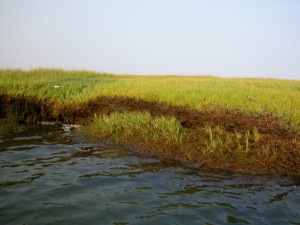No Wake Zones

Shallow root growth (a result of excessive sewage discharge) prevents marsh grasses from stabilizing the marshes. Strong boat wakes further erode the marshes that have protected our shoreline for generations.
Since 1990, Operation SPLASH has been instrumental in public awareness of salt marsh protection. Historically, the marsh protection was important for wildlife refuge and fish production.
The 2010 Total Maximum Daily Load studies from SOMASS provided clear data to show that nitrogen from the effluent being discharged into the bays has a direct effect on the resiliency of the our salt marsh vegetation. The spartina grasses no longer produce deep roots and are evolving into shallow rooted grasses.
Without the natural resources of deep rooted grasses in the salt marshes, salt march erosion is expedited at a dangerous rate.
Salt marshes are vital to absorb massive amounts of storm energy from hurricanes and northeasters, and by doing so they provide greater protection to the mainland.
Large boat wakes collapse and destroy salt marshes at a rapid rate.
Being a responsible boat handler, and observing signage along the waterways, is something that we can each do to slow this erosion.
